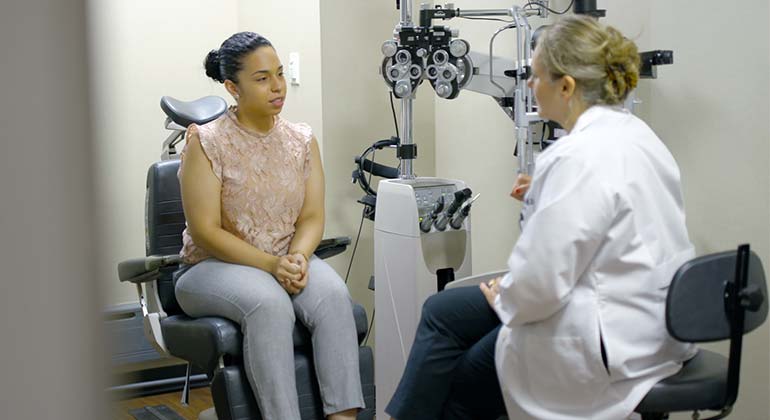The Benefits And Drawbacks of Various Refractive Surgical Procedures for Improved Eyecare

LASIK Surgery
LASIK surgical treatment is a generally performed refractive procedure that intends to fix vision concerns such as nearsightedness, astigmatism, and farsightedness. This medical method has actually gained popularity due to its effectiveness in supplying people with more clear vision and decreasing their dependency on glasses or get in touch with lenses. During the treatment, a slim flap is produced on the cornea, and a laser is made use of to improve the underlying cells, dealing with the refractive error. The flap is then rearranged, permitting for quick healing and very little pain for the person.
One of the main benefits of LASIK surgery is the quick improvement in vision experienced by many people. The majority of people see a considerable improvement in their vision quickly after the treatment, with marginal downtime required for recovery. In addition, LASIK is known for its high success price and reduced incidence of difficulties when done by competent surgeons. Nonetheless, like any type of medical treatment, LASIK likewise carries some threats, including dry eyes, glow, halos, and under or overcorrection of vision. It is necessary for individuals considering LASIK surgical procedure to undertake a complete examination by an eye care specialist to figure out if they are ideal candidates for the treatment.
PRK Procedure
The PRK procedure, likewise referred to as Photorefractive Keratectomy, is a kind of refractive surgical procedure that aims to fix vision issues comparable to LASIK surgery. Unlike LASIK, which includes producing a flap in the cornea, PRK services the surface area layer of the cornea. During the PRK treatment, the outer layer of the cornea, called the epithelium, is gotten rid of to permit reshaping of the underlying corneal tissue with an excimer laser. This reshaping helps to fix refractive mistakes such as astigmatism, nearsightedness, and farsightedness.
One of the benefits of PRK over LASIK is that it eliminates the danger of flap-related complications considering that no flap is created throughout the surgical procedure. In spite of the longer healing period, PRK can be a suitable choice for people looking for vision improvement surgical treatment.
SMILE Surgery
A cutting-edge refractive surgery strategy getting popularity in the area of ophthalmology is SMILE Surgical procedure. Tiny Incision Lenticule Removal (SMILE) is a minimally invasive treatment that remedies vision by reshaping the cornea utilizing a femtosecond laser. Unlike traditional LASIK surgical procedure, SMILE Surgery involves producing a tiny incision in the cornea to extract a lenticule, which results in much less disruption to the corneal structure and possibly quicker healing times.
Among the primary benefits of SMILE Surgery is its capacity to treat myopia (nearsightedness) and astigmatism with high accuracy, resulting in outstanding aesthetic outcomes for clients. The minimally intrusive nature of the procedure also decreases the threat of complications such as dry eye try these out disorder, making it a beneficial choice for people looking for refractive surgical procedure.

LASEK Strategy
Having actually discovered the advantages and factors to consider of SMILE Surgery, another noteworthy refractive surgical treatment method worth examining is the LASEK Technique. LASEK, which represents Laser-Assisted Subepithelial Keratectomy, is a kind of laser eye surgical procedure that intends to fix refractive errors such as nearsightedness (nearsightedness), hyperopia (farsightedness), and astigmatism.
Unlike LASIK, LASEK does not entail creating a corneal flap. Instead, throughout a LASEK treatment, the specialist utilizes a diluted alcohol solution to loosen up the thin external layer recommended you read of the cornea, referred to as the epithelium. This layer is then gently relocated apart to enable the laser to improve the underlying corneal cells. Once the cornea has actually been reshaped to the desired degree, the epithelial layer is repositioned.
Among the primary advantages of LASEK is that it can be appropriate for individuals with slim corneas that may not be great candidates for LASIK. In addition, LASEK generally leads to minimal post-operative discomfort and a quicker healing time contrasted to PRK. The aesthetic recovery process with LASEK may be a little longer than with LASIK.
Implantable Contact Lenses
Implantable Contact Lenses offer a lasting vision correction solution for people seeking an option to conventional contact lenses or glasses. These lenses, also referred to as phakic intraocular lenses, are operatively put into the eye to fix refractive errors such as nearsightedness (nearsightedness), hyperopia (farsightedness), and astigmatism. andalusia pediatrics. Unlike conventional call lenses that rest on the surface area of the eye, implantable get in touch with lenses function within the eye itself, offering clear vision without the requirement for daily maintenance or removal
Among the crucial advantages of implantable contact lenses is their durability. Once inserted, they can remain in the eye indefinitely, supplying secure and consistent vision adjustment. In addition, these lenses can be an exceptional choice for individuals that are bad prospects for laser eye surgical treatment or who choose a reversible vision adjustment treatment.
However, implantable contact lenses do bring some threats, consisting of the potential for cataracts or enhanced eye stress. It is crucial for individuals considering this alternative to talk to an eye care professional to identify if implantable contact lenses are the right choice for their details demands and eye health and try this wellness.
Final Thought
In conclusion, each type of refractive surgery has its very own benefits and downsides. LASIK surgical procedure is prominent for its fast recovery time, while PRK procedure might be ideal for patients with thin corneas.

In General, SMILE Surgery provides a promising alternative for individuals looking to boost their vision with refractive surgical treatment.